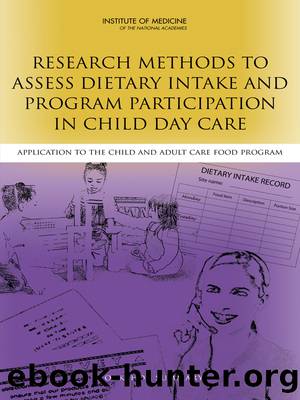Research Methods to Assess Dietary Intake and Program Participation in Child Day Care: Application to the Child and Adult Care Food Program: Workshop Summary by Leslie Pray

Author:Leslie Pray
Language: eng
Format: epub
Tags: ebook
Publisher: The National Academies Press
Published: 2012-12-28T00:00:00+00:00
DISCUSSION
Following Ritchie and Odoms-Youngâs presentations, workshop participants engaged in an open discussion on methodologies for assessing barriers and facilitators to implementing the recommended CACFP meal pattern requirements. Major topics of discussion were state-level âpreliminaryâ data, cost as a potential barrier, food insecurity as a potential barrier, and other macroenvironmental barriers. Each of these is discussed in more detail below.
State-Level âPreliminaryâ Data
There were several comments about the possibility of preliminary data on barriers and facilitators being collected in states that have been implementing new state nutrition guidelines for child care (e.g., California, Delaware, New York, and West Virginia). States often have a wealth of raw data but insufficient resources to analyze those data. If such data exist, they could help frame questions for a nationally representative study of child care. For example, one audience member remarked that, in New York, registered dietitians are entering homes to assist providers with implementing new state guidelines and there might be data available in the future on the ease, or difficulty, of making the required changes. Ritchie noted that the California state legislature passed a law regulating beverages in all child care centers and homes and that a statewide survey which is about to be launched will be providing data not just on how well the facilities conform to the new standards but also on barriers and facilitators to making the necessary changes. She said, âSome of those natural experiments and the lessons that we have learned from them will be very informativeâ and will âhelp frame how we ask questions for the national study.â
Cost as a Potential Barrier
Cost is often perceived as a significant barrier to implementing change in child care settings, yet many unanswered questions remain. A few audience members listed some of those questions. For example, what does it mean when providers say that certain foods cost âtoo muchâ? What are provider expectations around cost? How much do providers in family day care homes think about what food costs should be? Odoms-Young agreed that these are important questions to consider and suggested that some providers may be experiencing economic constraints similar to what the childrenâs families are experiencing.
Fred Glantz emphasized the importance of looking at the entire cost of an operation, not just the cost of the actual purchased food; for example, the cost of labor should be considered as well. If a home or center buys more prepared foods, the food cost will be higher than for a site that relies on raw ingredients because the cost of the processed food embodies the labor that went into the product(s). However, the total cost (food plus labor to prepare the food) for a home or center that buys raw ingredients may be similar.
Quantitative data on cost are especially lacking. This raises the question, how can cost data be collected in a family day care setting? If families are shopping for foods for their child day care programs while shopping for household foods, how are the costs separated? Ritchie identified two studies that have quantified costs in family child care homes (Monsivais and Johnson, 2012; Monsivais et al.
Download
This site does not store any files on its server. We only index and link to content provided by other sites. Please contact the content providers to delete copyright contents if any and email us, we'll remove relevant links or contents immediately.
| Administration & Medicine Economics | Allied Health Professions |
| Basic Sciences | Dentistry |
| History | Medical Informatics |
| Medicine | Nursing |
| Pharmacology | Psychology |
| Research | Veterinary Medicine |
Periodization Training for Sports by Tudor Bompa(7946)
Why We Sleep: Unlocking the Power of Sleep and Dreams by Matthew Walker(6386)
Paper Towns by Green John(4826)
The Immortal Life of Henrietta Lacks by Rebecca Skloot(4274)
The Sports Rules Book by Human Kinetics(4097)
Dynamic Alignment Through Imagery by Eric Franklin(3935)
ACSM's Complete Guide to Fitness & Health by ACSM(3834)
Kaplan MCAT Organic Chemistry Review: Created for MCAT 2015 (Kaplan Test Prep) by Kaplan(3815)
Introduction to Kinesiology by Shirl J. Hoffman(3634)
Livewired by David Eagleman(3547)
The River of Consciousness by Oliver Sacks(3431)
The Death of the Heart by Elizabeth Bowen(3355)
Alchemy and Alchemists by C. J. S. Thompson(3312)
Descartes' Error by Antonio Damasio(3170)
Bad Pharma by Ben Goldacre(3118)
The Gene: An Intimate History by Siddhartha Mukherjee(2942)
The Emperor of All Maladies: A Biography of Cancer by Siddhartha Mukherjee(2942)
The Fate of Rome: Climate, Disease, and the End of an Empire (The Princeton History of the Ancient World) by Kyle Harper(2893)
Kaplan MCAT Behavioral Sciences Review: Created for MCAT 2015 (Kaplan Test Prep) by Kaplan(2832)
